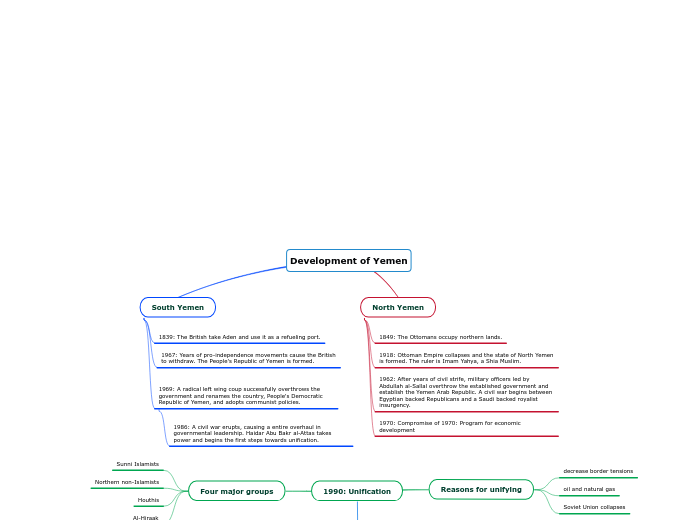Development of Yemen
South Yemen
1839: The British take Aden and use it as a refueling port.
1967: Years of pro-independence movements cause the British to withdraw. The People's Republic of Yemen is formed.
1969: A radical left wing coup successfully overthrows the government and renames the country, People's Democratic Republic of Yemen, and adopts communist policies.
1986: A civil war erupts, causing a entire overhaul in governmental leadership. Haidar Abu Bakr al-Attas takes power and begins the first steps towards unification.
North Yemen
1849: The Ottomans occupy northern lands.
1918: Ottoman Empire collapses and the state of North Yemen is formed. The ruler is Imam Yahya, a Shia Muslim.
1962: After years of civil strife, military officers led by Abdullah al-Sallal overthrow the established government and establish the Yemen Arab Republic. A civil war begins between Egyptian backed Republicans and a Saudi backed royalist insurgency.
1970: Compromise of 1970: Program for economic development
1990: Unification
Reasons for unifying
decrease border tensions
oil and natural gas
Soviet Union collapses
Four major groups
Sunni Islamists
Northern non-Islamists
Houthis
Al-Hiraak
1990-1994: Transition
Military never integrated
No plan for how institutions would look in a unified state
Continued mistrust
Democracy served as a barrier: Poor dispute resolution
1994: War of Sucession
South attempts to succeed; defeated by national army
1994-2004: Terrorism and Civil Strife
Terrorism
2000: USS Cole
2002: Limburg
Civil Conflict
2001: Violence during elections
calls for constitutional reform
2004: Hussein al-Houthi is martyred
2005- 2014: Houthi Insurgency and Calls for Reform
Houthi Insurgency
2005: 200 killed in fighting
2007: After more death, Abdul-Malilk al-Houthi
accepts ceasefire
2008: Renewed fighting
2009: Clashes between rebels and Saudi forces
Government Reform
2005: 36 dead in clashes between protestors and police
2007: Clashes between army and tribesman leave 16 dead
2008: Demands for electoral reform; accusations of northern bias
2011: President Selah steps down; President Hadi assumes control
2015-Present: ISIS and Civil War
2015
ISIS kills 137 people
President Hadi flees south
Saudi led coalition launches airstrikes against Houthis in Arden
2018
Southern separatists backed by UAE take Aden
2019
Military withdraw by UAE
2020
COVID-19 prompts ceasefire
2014: New constitution to include for Houthis and South; Houthis take Sanaa
Government forces: Saudi Arabia and US
Houthi Forces: Iran
Southern Separatists: UAE
Barriers to Development
State Capacity/ Institutions
Economic
Lack of economic diversification
Wealth contained by oligarchical elites
Political
Ineffective government/
Democratic institutions
Legitimate third parties
Geography
Lack of natural resources
Strategic location
Ethnic/Religious Conflict
Shia and Sunni Islam
Tribal groups
Oil Dependence
Price volatility
Limits financial development
